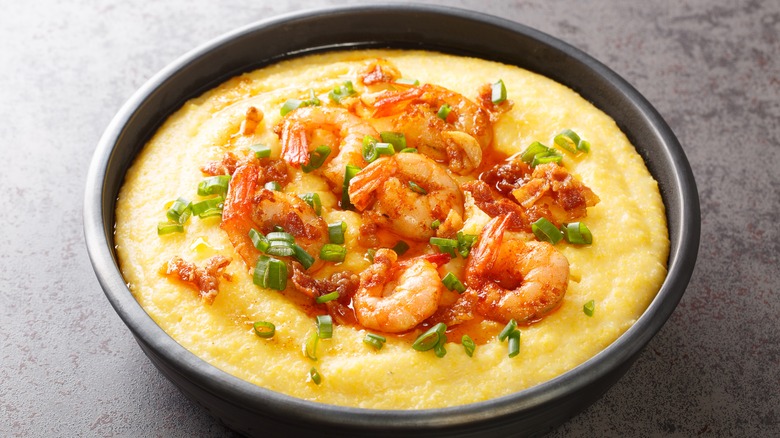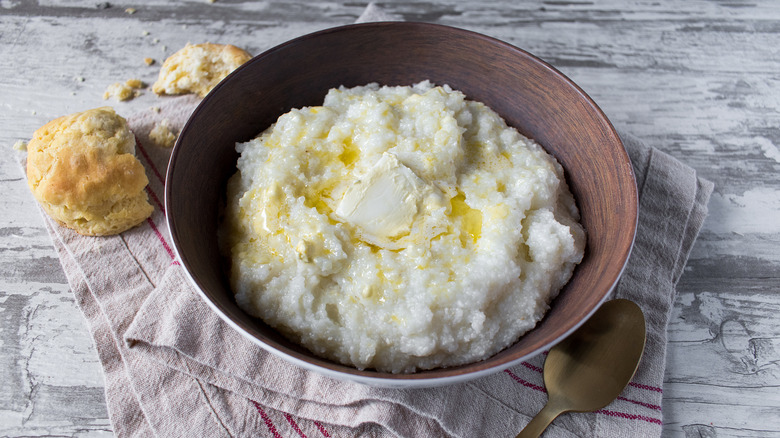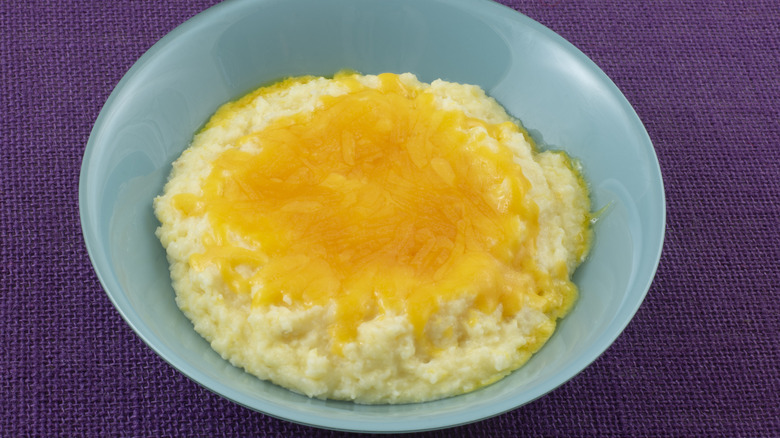For Perfect Grits, Mind The Temperature
Americans are big fans of corn in all its forms. From fresh on the cob, ground into masa for tortillas, or popped up hot at the movie theater, this staple crop that is native to North America is served in hundreds of ways and can be a part of any meal. Because we eat so much corn, which was the largest crop in the country in 2019, it's no surprise that we also like to celebrate the mighty cob with corn mazes in the fall, corn parades, and even a corn palace in Mitchell, South Dakota.
One of the best ways to prepare the aforementioned "big lump with knobs" is actually also one of the oldest — ground into cornmeal and cooked into grits. According to the book "Grits: A Cultural & Culinary Journey Through The South" by Erin Byers Murray, the history of the cereal grain goes all the way back to 8700 B.C.E. (per NPR). The traditional Native American dish is made using dried corn that is ground in a stone mill, which gives grits their distinctive texture (per Deep South Magazine). The cornmeal is then reconstituted with liquid (water or milk, or a combination) to make a porridge. Making grits is fairly straightforward, however, there are a few factors to keep in mind in order to get silky, creamy results.
Time and temperature matter
Much like other whole-grain cereals such as oatmeal, rice, and barley, grits take some time to cook and absorb moisture. They are made using a ratio of 4:1 or 5:1 liquid to grits, depending on how you want the texture to be, and most of the time you'll be starting with old-fashioned, stone ground grits, which take around 25 minutes to cook. The reason it takes so long to make regular (non-instant grits) is that they need slow, moist heat in order for the starches to gelatinize, which is when the individual starch granules swell and absorb the liquid. Once the granules reach the right temperature and absorb a certain amount of water, they will burst and release the starch into the liquid, which is what makes them thick (per Love Food Love Science).
To make your grits perfectly smooth and creamy, MasterClass says that you should avoid using high heat, which can make them runny. This is because the corn granules can't be forced into quickly converting their starch with high temperatures, and you need to give them time to slowly do their thing. Bring your water, milk, or stock to a boil, add the grits, and turn the heat down to medium-low, stirring constantly so they don't stick together in clumps or burn on the bottom of the pot.
Types of grits
When you head to the grocery store for grits you'll probably see a couple of different versions, including stone ground, quick-cooking, instant, and hominy (per Real Simple). Stone ground grits are the coarsest, least processed variety and take the longest to cook. Hominy grits, which are the most common in grocery stores and cook a little faster, are made by soaking the corn kernels in an alkali solution to remove the husk and then drying and ground. The instant and quick-cooking varieties are partially cooked at the factory and then dehydrated before packaging — exactly like minute rice and instant oatmeal — and take only a few minutes to make.
If you're making grits on the stovetop and they're still not coming out exactly the way you want them, remember that low and slow is the way to go. Greg Johnsman, restaurateur, farmer, and "masterful miller who produces the famed Marsh Hen Mill brand of grits," explains that the most important ingredient to cooking perfect grits is patience (per Discover South Carolina).
If your grits still aren't exactly how you want them, you can try adding more or less liquid. And be sure to leave them to rest or "set" for ten minutes or so after taking them off the heat. If the stovetop is all too much, however, you can also make delicious grits using a slow cooker, baking them in the oven, or even using a rice cooker.


